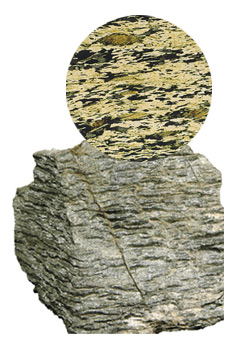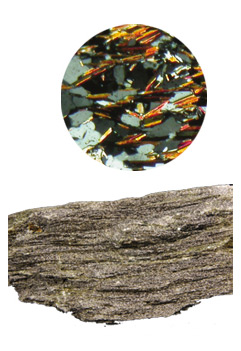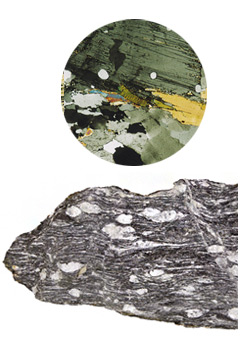Metamorphic Rocks
Metamorphic rocks are formed from preexisting rocks by subjection to high temperatures and pressures at depth in the Earth's crust, resulting in new mineral assemblage and texture. Metamorphic rocks are classified on the basis of the causes of metamorphism, their texture and the preexisting mother rock.

Coastal outcrop showing leucocratic granite gneiss
Donghae, Korea
Classification by cause│Metamorphic rocks are classified into 1) dynamic metamorphic rocks formed by recrystallization during crushing and shearing (e.g., cataclasites such as mylonite, pseudotachylite and augen gneiss), 2) regional metamorphic rocks including gneiss, schist and slate, metamorphosed by pressure and heat, and 3) contact metamorphic rocks represented by hornfels due to heat alone.
Classification by texture│Slate, phyllite, schist and gneiss are metamorphic rocks with parallel planar textures or foliations and vary from microcrystalline (slate) to coarse-grained (gneiss). Mylonite shows some ductile deformation features.
Classification by parent rocks│Metamorphic rocks are also classified based on parent rocks, such as quartzite, marble, meta-argillite and amphibolite Metasedimentary rocks include marble (metamorphosed limestone), quartzite (metamorphosed quartz-rich sandstone), meta-argillite (metamorphosed mudstone). Amphibolite, rich in amphiboles, is formed by metamorphism of basaltic rocks.

Marble Jeongseon, Korea
Marble is formed by recrystallization of limestone and dolomite, commonly used for carving stone or building stone.

Mylonite Chungju, Korea
Mylonite shows banded structure resulting from severe mylonitization.

Slate
Boeun, Korea
Slate is a low-grade metamorphic rock, characterized by well-developed cleavage.

Phyllite
Cheongwon, Korea
Phyllite consists of fine-grained sericite with wavy foliation planes.

Schist
Chuncheon, Korea
Schist shows well-developed schistosity.

Gneiss
Chuncheon, Korea
Augen gneiss shows eye-shaped, feldspar porphyroblasts.